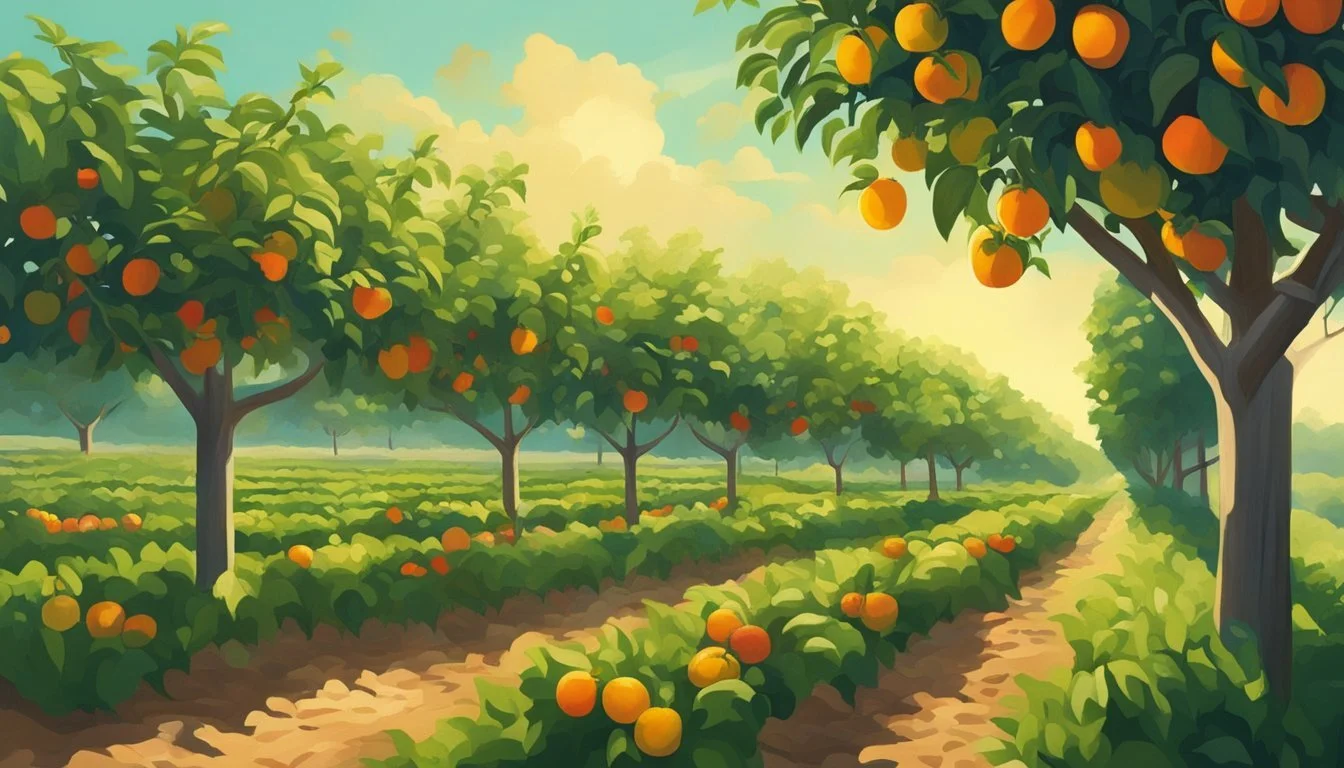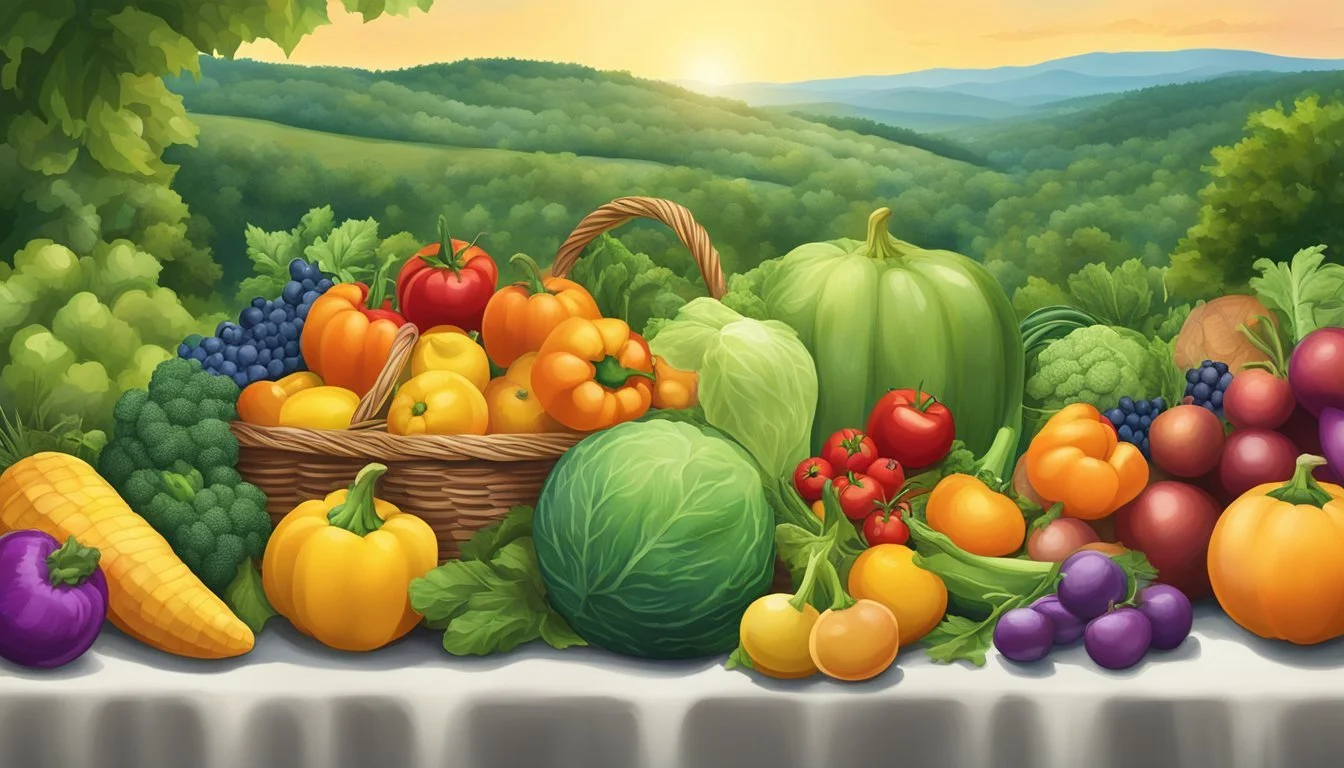West Virginia Seasonal Fruit & Vegetables in August
Your Fresh Picks Guide
This Article is Part of our West Virginia Seasonal Fruit & Veg Calendar
In West Virginia, August marks the high tide of summer's bounty, offering a wide array of fruits and vegetables at their peak of freshness. It's a time when local farmers' markets and roadside stands become hubs of vibrant activity, boasting the season's best harvest. The warm days and rich soil in the state's diverse regions contribute to the growth of a variety of produce that not only support local agriculture but also provide the freshest options for healthy eating.
During this month, the selection includes sweet and juicy fruits such as watermelons, peaches, blueberries (how long do blueberries last?), and grapes, which are all in their prime. These are complemented by a range of robust vegetables like tomatoes, cucumbers (how long do cucumbers last?), and peppers, making August an ideal time for West Virginians to harness the full, flavorful potential of their local produce. Moreover, the availability of such diverse crops underscores the importance of seasonal eating, directly linking consumers with the natural growing cycles of their region.
Gardens and orchards in West Virginia not only resonate with the traditional Appalachian culture but also reflect the dedication to sustainable farming practices. As the state's residents enjoy the abundance of August, they also celebrate the local agriculture that reliably provides these seasonal delights year after year. Through supporting these seasonal harvests, consumers contribute to the local economy and encourage a food system that prizes quality and environmental stewardship.
Overview of West Virginia's Growing Season
West Virginia boasts a notably diverse climate which is highly conducive to a variety of crops. Its growing seasons fluctuate across the state but share some common characteristics that influence the availability and variety of produce through the year.
March marks the beginning of the warmer period with a gradual rise in temperatures laying the groundwork for planting. By the time July arrives, the state is well into its prime growing season. The warm and humid climate of West Virginia in July and August is ideal for a range of fruits and vegetables.
August especially is a peak month for harvests. Many crops that were planted in the spring and early summer are ready to be picked. The state's typical offerings during this time include:
Fruits: Blackberries (how long do blackberries last?), blueberries, peaches, plums, and melons
Vegetables: Tomatoes, green beans, peppers
Primary Fruit Harvests in August
In August, West Virginia's fertile lands offer an abundance of fruit harvests, with stone fruits, berries, and melons reaching their peak ripeness.
Stone Fruits
The stone fruit harvest in August is vibrant, boasting a variety of peaches, plums, and nectarines. Peaches are particularly succulent at this time, with varieties such as Red Haven and Georgia Belle being widely available. Plums also share the spotlight, offering both sweet and tart flavors, while nectarines provide a juicy, smooth-skinned alternative to their fuzzy counterparts.
Berries
Berry harvests in August present a juicy selection, with blueberries, blackberries, and raspberries in abundant supply. Farmers' markets and pick-your-own farms are bustling as:
Blueberries are commonly found, with their sweet-tart flavor profile.
Blackberries invite picking with their deep, dark color and rich taste.
Raspberries round out the berry offerings with their distinctively sweet and slightly tart flavor.
Melons
Melons are a highlight in August, with watermelons and cantaloupes (how long does cantaloupe last?) being the most sought after. These melons are known for their refreshingly sweet taste and are perfect for hot summer days:
Watermelons come in various sizes, from small personal varieties to larger types suitable for sharing.
Cantaloupes are equally popular, appreciated for their fragrant aroma and rich flavor.
Fresh Vegetables Available
West Virginia offers an abundance of fresh vegetables in August. The warm climate and fertile soil provide ideal conditions for a variety of produce to thrive.
Nightshade Vegetables
Tomatoes: Ranging from cherry to beefsteak types, tomatoes are ripe and abundant.
Eggplant (What wine goes well with eggplant?): These glossy purple vegetables are available in various shapes and sizes.
Peppers: Sweet bell peppers to hot varieties are in their prime, perfect for a range of dishes.
Gourds and Squash
Zucchini: This versatile summer squash is commonly found in gardens and markets.
Cucumbers: Crisp and refreshing, cucumbers are plentiful during this month.
Summer Squash: Including varieties like yellow crookneck and pattypan, summer squash is a staple.
Leafy Greens
Kale: A nutritious leafy green, kale is hearty and grows well during this period.
Spinach: Tender and fresh, spinach leaves are perfect for salads and cooking.
Arugula:(how long does arugula last?) With its peppery flavor, arugula makes a great addition to any salad blend.
Root Vegetables
Potatoes: A staple root vegetable, found in a variety of types.
Carrots: Sweet and crunchy, carrots are harvested during this time.
Beets: Earthy and deep red, beets are ideal for roasting or salads.
Radishes: Sharp and peppery, radishes add a crunch to salads and side dishes.
Turnips: Often overlooked, turnips are versatile and flavorful.
Herbs and Additional Crops
In the verdant hills of West Virginia, August marks a bountiful period for gardeners and farmers cultivating a variety of herbs and crops. Vigorous growth and favorable weather lend themselves to a robust harvest.
Herbs: They thrive in the warm and transitioning climate. Gardeners can optimally harvest basil, parsley, and sage, each herb offering unique flavors and culinary uses. Basil is prolific during this time and is essential for pesto and other fresh dishes. Parsley is not only a garnish but also a versatile herb that enhances the taste of sauces and soups. Sage, with its earthy aroma, is perfect for seasoning meats and savory dishes.
Harvesting Tips:
Ensure ample foliage remains for the plants to sustain growth after pruning.
Up to 50-75% of cilantro and other herbs can be harvested if the plant size allows.
Shelling Beans: These beans, still in their protective pods, are another valuable crop ready for picking in the month of August. They should be harvested when the pods are plump.
Crop Harvesting Instruction Shelling Beans Pick when pods are plump but not overly dry.
Zucchini Blossoms: A delicacy in many cuisines, zucchini blossoms are best picked in the cool of the morning. They are often stuffed and fried, showcasing the region's agricultural diversity and culinary creativity.
By maintaining diligent watering practices and utilizing shade when necessary, growers ensure the vitality and yield of their herbs and crops during this plentiful season.
Farmers' Market Tips for August
Visiting farmers' markets in West Virginia during August offers a vibrant array of fresh produce. They should be prepared to enjoy the peak harvest times of a variety of fruits and vegetables. To ensure the freshest picks, they may refer to a produce calendar but some staples to look for include:
Fruits:
Vegetables:
Tomatoes: Ripe and ready in various sizes and colors.
Sweet corn: Look for ears with bright, moist silks.
Eggplants and Tomatoes: These summer favorites are abundant.
They should arrive early for the best selection. Market goers are encouraged to speak directly to farmers for insights on the freshest produce and recipe ideas. Building a relationship with local growers can provide a wealth of knowledge regarding ideal harvest times and preparation methods.
Storage Tips: To maximize freshness, they should store tender fruit like berries in the refrigerator, while tomatoes fare better at room temperature. Leafy greens should be washed and kept in an airtight container.
Remember, produce found at farmers' markets often surpasses the freshness of supermarket counterparts, as fruits and vegetables are commonly picked within 24 hours of market days. For those interested in the most current offerings, several markets and local food groups maintain online calendars or social media updates.
Planning and Preservation
August in West Virginia presents a prime time for gardeners to plan ahead and preserve the bounty of seasonal fruits and vegetables. They must first pay attention to frost dates and ensure that their chosen crops can mature before the first killing frost, traditionally around October 10 for many regions in the state.
Seeds selection for late summer planting should focus on fast-maturing varieties to optimize the harvest window. The availability of certain crops in August encourages gardeners to consider both preservation methods and water management to maintain their gardens.
Watering practices should adapt to the warm August weather, providing consistent moisture without over-watering, which might lead to root rot or other issues. Gardeners should monitor local weather forecasts and adjust their watering schedule accordingly to avoid drought stress or waterlogging in their gardens.
Preservation of produce is crucial to extend the enjoyment of fruits and vegetables beyond their peak seasons. For instance:
Fruits like blackberries, blueberries, and peaches can be preserved through canning, freezing, or drying.
Vegetables are also amenable to preservation. Canning, pickling, and fermenting are common methods that ensure vegetables like cucumbers and beans remain available after the growing season ends.
Here is a brief list of produce for preservation:
Fruits Preservation Methods Blackberries Canning, Freezing, Jam Blueberries Freezing, Drying Peaches Canning, Jam
Vegetables Preservation Methods Cucumbers Pickling Green Beans Canning, Freezing
Gardeners should invest in quality preservation equipment and follow precise methods to maintain the nutritional value and taste of their harvest. Proper labeling and storage of preserved goods will ensure a well-stocked pantry through the winter months.
Seasonal Recipes and Uses
In West Virginia, August is a time when the summer bounty is truly at its peak. The freshness of local produce can be savored in numerous dishes that celebrate the season's flavors. One can enjoy the simplicity of summer fruits like blueberries and peaches, which can be utilized in a wide array of recipes—from smoothies to tarts.
Fruit/Vegetable Recipe Ideas Blueberries Blueberry muffins Cantaloupes Cantaloupe and prosciutto salad Peaches Grilled peach halves Watermelons Watermelon feta salad Pears Pear and arugula pizza
August's crop availability invites one to combine fruits like peaches and berries in a refreshing fruit salad, or blend them for a nutritious morning smoothie. Vegetables such as tomatoes and cucumbers offer a crisp, cool contrast in summer salads, while grilling stone fruits like peaches can highlight their sweetness and add a smoky dimension to desserts or savory dishes.
The abundance of produce means there's ample opportunity to explore fresh, seasonal recipes like salsa with garden-fresh tomatoes or zucchini bread that makes the most of the summer squash. They not only prepare the palate for the rich flavors of late summer but also capitalize on the nutritional value of food at its freshest. Whether one is aiming for sweet or savory, local farmers' markets in West Virginia during August present a variety of foods to create gastronomic delights that are as fresh as they are tasty.









